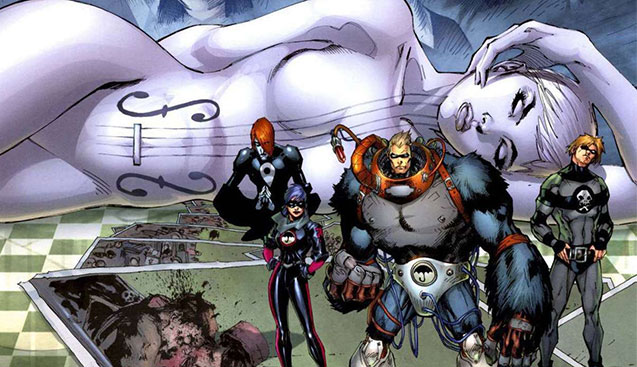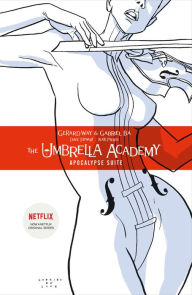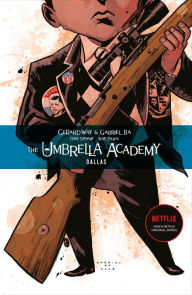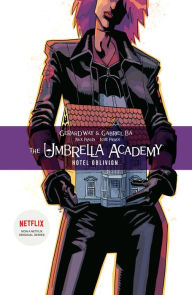The Umbrella Academy Makes a Perfectly Improbable Leap from Page to Screen
 The Umbrella Academy unfurled on Netflix earlier this month, spreading itself out on our screens with bombast. Based on the quirky graphic novel series by Gerard Way and Gabriel Bá, the show explores what it might truly mean to grow up with super powers, mixing slick ultra-violence, childhood drama, and absurdist humor with impeccable style. It is a breath of fresh air in a time when television is choked with more superhero shows than it seems possible for any one person to follow (case in point: on the same day The Umbrella Academy dropped, the new streaming service from publisher DC debuted another revisionist comic adaptation, Doom Patrol).
The Umbrella Academy unfurled on Netflix earlier this month, spreading itself out on our screens with bombast. Based on the quirky graphic novel series by Gerard Way and Gabriel Bá, the show explores what it might truly mean to grow up with super powers, mixing slick ultra-violence, childhood drama, and absurdist humor with impeccable style. It is a breath of fresh air in a time when television is choked with more superhero shows than it seems possible for any one person to follow (case in point: on the same day The Umbrella Academy dropped, the new streaming service from publisher DC debuted another revisionist comic adaptation, Doom Patrol).
The Umbrella Academy, Volume 1: Apocalypse Suite
The Umbrella Academy, Volume 1: Apocalypse Suite
By
Gerard Way
Illustrator
Various
In Stock Online
Paperback $17.99
I’ve been a fan of Gerard Way for a long time. My fandom began with his band, My Chemical Romance, my devotion to which meant I’d follow him to the ends of the earth. Certainly, I didn’t hesitate when I heard he was putting out a comic. In the mid-2000s, Way—who was raised on the medium and allowed its influence on him to bleed through into his music—concocted an incredible idea for a subversive hero comic following seven super-powered siblings (each with their own code name and numerical identifier) who grow up to be maladjusted adults, only to be suddenly tasked with saving the world.
I’ve been a fan of Gerard Way for a long time. My fandom began with his band, My Chemical Romance, my devotion to which meant I’d follow him to the ends of the earth. Certainly, I didn’t hesitate when I heard he was putting out a comic. In the mid-2000s, Way—who was raised on the medium and allowed its influence on him to bleed through into his music—concocted an incredible idea for a subversive hero comic following seven super-powered siblings (each with their own code name and numerical identifier) who grow up to be maladjusted adults, only to be suddenly tasked with saving the world.
Published between 2007 and 2013 as two mini-series, plus a few standalone stories, the comic picked up an Eisner Award for Best Limited Series in 2008, thanks in no small part to Gabriel Bá’s instantly iconic art, which made Way’s writing soar and gave the series its own unique flair—which, impossibly seems to have translated quite well to the screen. With a rich color palette, careful framing, and an offbeat sense of absurd humor—not to mention a healthy smattering of voice-over narration—developed by Steve Blackman (Fargo) and Jeremy Slater (the live-action Death Note film), Netflix’s take on The Umbrella Academy resembles nothing so much as a superhero story by way of Wes Anderson’s The Royal Tenenbaums.
The Umbrella Academy, Volume 2: Dallas
The Umbrella Academy, Volume 2: Dallas
By
Gerard Way
Illustrator
Various
In Stock Online
Paperback $17.99
The adaptation combines the first two graphic novel volumes, The Apocalypse Suite and Dallas, into one cohesive plot stretching across 10 episodes. It deftly mixes characters and set pieces from each into a narrative that is engaging, suspenseful, and largely free of the bloat that has plagued many a streaming series in the past. As a devoted fan of the books, I at first quibbled at some of the liberties being taken with the plot and characterization, but it gets the important stuff entirely right.
The adaptation combines the first two graphic novel volumes, The Apocalypse Suite and Dallas, into one cohesive plot stretching across 10 episodes. It deftly mixes characters and set pieces from each into a narrative that is engaging, suspenseful, and largely free of the bloat that has plagued many a streaming series in the past. As a devoted fan of the books, I at first quibbled at some of the liberties being taken with the plot and characterization, but it gets the important stuff entirely right.
My favorite character, the clairvoyant Klaus, fares very well: he’s a sarcastic, drugged out, goth-y mess of a human, played with charm and a hidden, haunted sadness by Robert Sheehan. Number Five, the lost brother of the family, who misjudged his time jumping ability and spent decades living alone in a post-apocalyptic future, only to come back to the present day in his original body, is one of the comics’ most sympathetic characters. Aidan Gallagher captures him perfectly, bouncing from cold-hearted killer to young kid at a blink. Ellen Page—certainly the most recognizable member of the cast—deserves particular notice for her portrayal of Vanya, the “ordinary” seventh member of the family. She plays her with kindness and a quiet, lingering sadness that anchors the madness whirling around her.
In some areas, the show builds upon the ideas in the source material to create something new. On the page, Klaus visits Vietnam with two of his siblings, and their trip is played largely for comedy. In the show he goes alone, and what he experiences there—including his relationship with a man named Dave, who becomes something of a love interest—hits like a punch to the gut, changing his character arc in interesting ways. I’m usually a grump about it when an an adaptation veers from the source material, but again and again, The Umbrella Academy succeeds by doing just that.
Another way the show stands apart is through its use of music—not exactly a factor on the printed page. (It’s almost like Gerard Way is a musician or something.) The utterly inspired use of Tiffany’s ’80s’s pop anthem “I Think We’re Alone Now” to underscore an impromptu house dance party in the trailer sets the tone for the whole show. Other notable music moments: The Bay City Rollers cheesy stomper “Saturday Night,” pairs perfectly with a gunfight in a bowling alley; They Might Be Giant’s iconic “Istanbul” blares as Number Five faces down a platoon of masked goons in a donut shop. Way even gets into the act, reuniting with My Chemical Romance’s original guitarist, Ray Toro, to record two cover songs.
Even at this late date in the comics-to-screen era, the translation from four-color page to screen is still a tricky one. So many of the cartoony elements and over-the-top action beats inherent to the medium just don’t work the same way in live action. Netflix’s take on The Umbrella Academy does a good job of leaning into the realism while preserving some of the zanier moments. Only in the anything-goes television landscape of 2019 would an adaptation retain a character like Pogo, the monkey butler and helper to the heroes of the UA. On the page, he’s one more weird letter in a bowl of alphabet soup in an alien language. Making him work onscreen, both as a character and a special effect, must’ve been incredibly tricky. The show deploys him in just the right way.
The Umbrella Academy Volume 3: Hotel Oblivion
The Umbrella Academy Volume 3: Hotel Oblivion
By
Gerard Way
Illustrator
Gabriel Ba
Introduction
Jeff Lemire
In Stock Online
Paperback $19.99
Other wacky elements didn’t make the cut, sadly. Early in the comics, the heroes face down a band of floating robotic death machines. In the show, they’re merely masked assassins. Vanya—whose UA alias is the White Violin—undergoes a much less dramatic transformation than she does in the graphic novel: she still turns white, but she doesn’t become a living violin. (Yes, it’s that kind of comic.) In these cases, the tradeoffs make logical sense, even when you sometimes wish the show had gone for the weirder choice. But that’s why we have comics—where the show strives for (and attains) a fantastic balance between realism and the absurd, the comic can go as far over-the-top as it wants (and it goes pretty far).
Other wacky elements didn’t make the cut, sadly. Early in the comics, the heroes face down a band of floating robotic death machines. In the show, they’re merely masked assassins. Vanya—whose UA alias is the White Violin—undergoes a much less dramatic transformation than she does in the graphic novel: she still turns white, but she doesn’t become a living violin. (Yes, it’s that kind of comic.) In these cases, the tradeoffs make logical sense, even when you sometimes wish the show had gone for the weirder choice. But that’s why we have comics—where the show strives for (and attains) a fantastic balance between realism and the absurd, the comic can go as far over-the-top as it wants (and it goes pretty far).
By sticking close to its source material, The Umbrella Academy delivers everything you could ask for from a superhero show. It doesn’t lean on tired tropes, and its heroes—and their powers—are interesting, unusual, and, most critically, unique. But its even better when paired with the comics themselves—not only to hold off your ennui at having to wait for a second season, but to allow you to get ahead of the game. You’ll want to be ready when the third volume, Hotel Oblivion—collecting on the first new UA stories in five years—arrives this summer.


